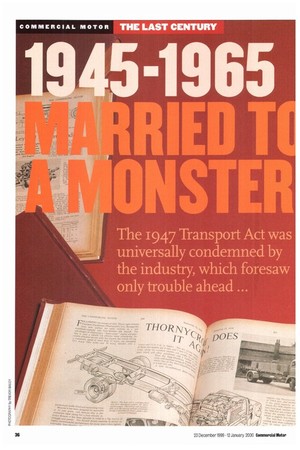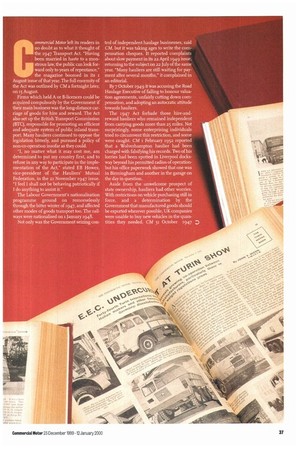The 1947 Transport Act was universally condemned by the industry, which foresaw only trouble ahead
Page 38

Page 39

Page 40

Page 41

If you've noticed an error in this article please click here to report it so we can fix it.
ommercial Motor left its readers in no doubt as to what it thought of the 1947 Transport Act, "Having been married in haste to a monstrous law, the public can look forward only to years of repentance," the magazine boomed in its August issue of that year. The full enormity of the Act was outlined by CM a fortnight later, on i5 August.
Firms which held A or B-licences could be acquired compulsorily by the Government if their main business was the long-distance carriage of goods for hire and reward. The Act also set up the British Transport Commission (BTC), responsible for promoting an efficient and adequate system of public inland transport. Many hauliers continued to oppose the legislation bitterly, and pursued a policy of non-co-operation insofar as they could.
"I, no matter what it may cost me, am determined to put my country first, and to refuse in any way to participate in the implementation of the Act," stated EB Howes, vice-president of the Hauliers' Mutual Federation, in the 21 November 1947 issue. "I feel I shall not be behaving patriotically if I do anything to assist it."
The Labour Government's nationalisation programme ground on remorselessly through the bitter winter of1947, and affected other modes of goods transport too. The railways were nationalised on 1 January1948.
Not only was the Government seizing con
trol of independent haulage businesses, said CM, but it was taking ages to write the compensation cheques. It reported complaints about slow payment in its 22 April 1949 issue, returning to the subject on 22 July of the same year. "Many hauliers are still waiting for payment after several months," it complained in an editorial.
By 7 October 1949 it was accusing the Road Haulage Executive of failing to honour valuation agreements, unfairly cutting down compensation, and adopting an autocratic attitude towards hauliers.
The 1947 Act forbade those hire-andreward hauliers who remained independent from carrying goods more than 25 miles. Not surprisingly, some enterprising individuals tried to circumvent this restriction, and some were caught. CM i February 1952 reported that a Wolverhampton haulier had been charged with falsifying his records. Two of his lorries had been spotted in Liverpool docksway beyond his permitted radius of operationbut his office paperwork showed that one was in Birmingham and another in the garage on the day in question.
Aside from the unwelcome prospect of state ownership, hauliers had other worries. With restrictions on vehicle purchasing still in force, and a determination by the Government that manufactured goods should be exported wherever possible, UK companies were unable to buy new vehicles in the quantities they needed. CM 31 October t947
D expressed concern that the lorry parc was gradually wearing out, and complained about a shortage of spares.
But if they weren't always able to buy lorries, at least they could read about them as manufacturers returned to civilian production. CM 9 January 1948 carried a report on the introduction of an ERF Model 4.4 8-tonner, powered by a 68hp Gardner engine and equipped with Lockheed hydraulic brakes. And CM's road test programme continued unchecked.
In the issue of 8 April 1949 the magazine sampled an AEC Mammoth Major eight-wheeler powered by a I25hp 9.6-litre six-cylinder diesel engine. It returned 8.6mpg at an average 26mph.
or were light vehi cles neglected, and CM's testers seemed to delight in giving them a
real drubbing. CM 7 March 1952 carried a report on an Austin A7o 15cwt pick-up which the test team took on a 30-mile endurance run across fields, unmade roads, through quarries and into a sandpit.
Only minor failings were recorded, however, and in CM's view these could be cured by modifying the front suspension and moving the number plate. The same issue also contained the UK motor industry's biggest news of that year—the merger of Austin and Morris to form BMC.
By 1952 the Conservatives were back in power, and the 1953 Transport Act heralded a return to free competition in long-distance haulage. By I January 1955 the 25-mile limit had been abolished, and all A-licence holders
enjoyed the freedom to carry any goods anywhere.
The BTC remained in place for several years, however, and CM was wor
tied that British Road Services, the state-owned road transport company, would remain a powerful rival to independent interests, and one backed by taxpayers' money. Not surprisingly, it was pleased when the BTC began to sell off lorries.
CM 16 October 1953 reported that 2,000 were to be disposed of in lots of one to four, and the sell-off gradually gained momentum. Come 14 January 1955 the BTC was requesting bids for 149 transport depots with 5,850 trucks between them, although a 7 January news story had warned that BRS lorries weren't always in as good a condition as might have been expected.
Perhaps the framers of the Road Traffic Act 1956 had encountered some of these vehicles somewhere along the line. They decided that lorries which were io years old or more should be subjected to testing (CM io August 1956).
Then, as now, nobody could accuse CM of being insular While UK manufacturers dominated the scene in the early fifties, the maga
zine didn't ignore what makers from other countries had to offer, even though it would be many years before their products were seen in overwhelming numbers on British roads.
On 1 January 1954, for example, CM tested a Volvo L399 eight-tonner in Sweden and liked it a lot. "It yields economy at high speed," said the report, adding that the position of its seats, steering wheel and controls made for comfort on long-distance runs.
Global events were soon to have a massive impact on British haulage. The 1956 Suez crisis resulted in a to% cut in fuel supplies (CM 16 November 1956). That week saw BRS park U p io% of its fleet.
A week later fuel supplies for lorries were more than halved, and CM announced that fuel coupons were to be issued. By it January 1957 hauliers were in dire trouble as a result of rationing. "Torrents of grim reports from all overBritain mock government optimism," said a CM editorial.
Twelve months later, however, the crisis had been forgotten, and a mood of optimism pervaded the magazine. CM5 December i958 reported Prime Minister Harold MacMillan's opening of the first stretch of motorway—an eight. mile section of the Preston bypass—and an intrepid CM tester took a Leyland Super Comet along it at over 70mph; there was no speed limit for lorries on motorways, unless they were towing a trailer. It was perfectly safe," he enthused.
CM had carried a report on Super Comet's launch on 19 September 1958. The prospect of Britain joining the Common Market (which as it turned out didn't happen until the early Seventies) also prompted increased interest in international transporL Only a few UK hauliers were involved in cross-border work in the late fifties and early sixties, but on 28 December 19 62 CM ran a story on an Atkinson eight-wheeler used to haul chemicals between north Germany and Yorkshire. Progress was slow. The Gardnerpowered Atkinson was geared to 42mph, and was constantly overtaken by Continental trucks travelling at 6omph. By 23 October 1964, however, Hatter Brothers of West Thurrock, Essex, were courageous enough to run a regular groupage service between their home base and Milan via the Brenner pass using a Scammell Highwayman and a tandem-axle trailer. s CM reported on 7 August, 1964 saw the introduction of the 32-ton gross weight limit for artics and plated weights. Throughout the fifties and sixties British truck and bus manufacturers poured forth a stream of new products and technical innovations. And CM remained eager to report upon and test them wherever possible.
CM 18 December 1959, for instance, found its testers getting to grips with a Guy Invincible Mk II eight-wheeler with a r5ohp Gardner 6LX engine and a six-speed gearbox. One-hundred-and-fifty horses and six speeds were becoming more popular, they suggested, thanks to the opportunities the motorways offered for sustained high-speed running.
Nor were those reports confined to trucks; trailers and bodywork were thoroughly covered too. On 22 August 1958 CM reported that RA Dyson would be displaying trailers with disc brakes and air suspension at the Earls Court Show, while on 15 January 1960 it announced that Thermo King refrigeration units would soon be available through Hawker Siddeley.
They were half the size of existing refrigeration units, CM said, with everything contained in a box mounted either on top of the lorry's cab or on the front of an artic's semi trailer. Bus and coach activities continued to receive extensive coverage, and 17 October 1958 saw CM testing the new Leyland Atlantean 78-seater double-decker, and praising it for its good overall performance among other virtues.
The capacity of commercial vehicles to cause environmental problems was a concern even 40 years ago. On 13 April 1962 CM warned that the Ministry of Transport aimed to carry out countrywide checks on lorry exhausts emitting excessive smoke. Delays in loading and unloading vehicles were also a problem then, and on 12 October r962 CM announced the launch of the "Turn that lorry round" campaign, implemented by the Road Haulage Association and BRS.
By the early sixties Britain was home to the biggest heavy truck manufacturer in the world. On 8 June 1962 CM announced the merger of Leyland— which included Albion, Scammell, and Standard Triumph—with
Associated Com mercial Vehicles, which embraced AEC and Thomycroft.
On 9 September 1960 CM reported the launch of the Bedford TK—the Tj had been launched two years previously—and by 19 July 1963 Bedford was building hundreds of lorries a week. Not wishing to be outpaced by a General Motors offshoot, Ford was busy in Britain too.
ome 27 August 1965, CM was putting the new D Series through its paces—"seldom have I handled a vehicle which responded so accurately as this one," said the tester—
while on 8 October 1965 CM announced the launch of one of the most successful CVs ever: the all-conquering Ford Transit.
With Ford having recently introduced a ri5hp turbo-diesel Transit, it's interesting to note that the first Transit's diesel option was a Perkins 4.99 engine. Output? A modest 4o.7hp.
DATES
1948 ,ItiS created.., gate of Israel founded.
1950 Petrol rationing ends.
Korean war begins. 1951 Festival of Britain. 1952 King George VI dies. 1953 Hillary and Tensing
conquer Everest.
The Coronation.
1956 Nasser seizes Suez Canal.
1958 "Bushy Babes" die in
Munich air crash.
1959 First hovercraft built. 1961 Yuri Gagarin first into space.
1962 Nelson Mandela jailed. 1963 Kennedy assassinated. 1965 Churchill dies.
"A stern warning was issued to drivers by Mr Ernest Maples, Minister of Transport, when he opened the London-Birmingham motorway on Monday. The M1 would bring immense benefits if drivers used discipline, common sense and obeyed the rides. But disaster and tragedy might descend on those who drive recklessly or selfishly." CM6 November 1959.




















































































































































